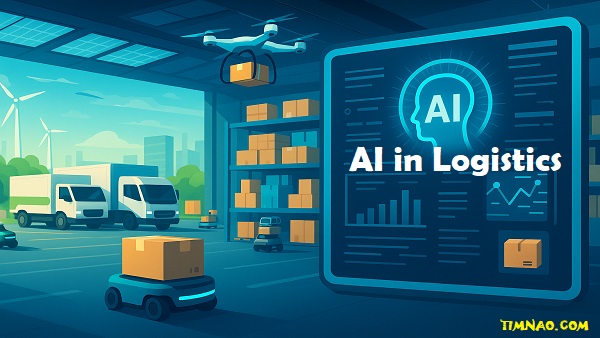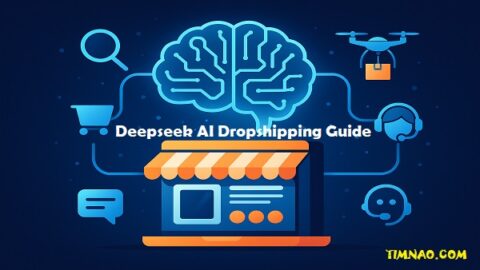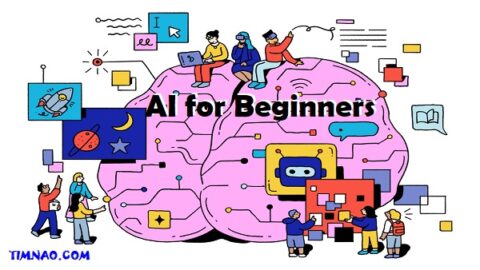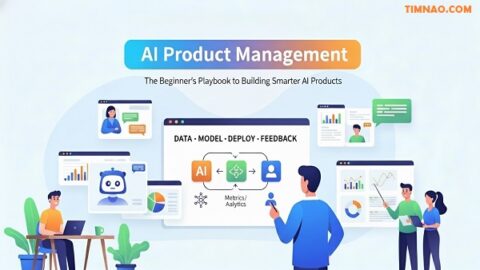🏆 Article Title: Why Smart Logistics Are Winning: How AI Is Revolutionizing the Industry 🚛
AI in logistics is no longer a futuristic concept — it’s the engine quietly driving today’s smartest and most sustainable supply chains.
From self-optimizing warehouses to real-time route adjustments, artificial intelligence is transforming how goods move across the globe. Companies that embrace this shift are seeing faster deliveries, lower costs, and happier customers.
But it’s not just about speed and savings. AI also helps reduce waste, shrink carbon footprints, and build more resilient logistics networks.
Still, if you’re just starting out, understanding AI can feel overwhelming. How does it work? Where should you begin? What tools actually make a difference?
This beginner-friendly guide breaks it all down — with real-world examples, simple explanations, and actionable insights. Whether you’re a business owner, operations manager, or tech-curious learner, you’ll find everything you need to get started with smart logistics.
📚 Table of Contents
- 🌍 The AI Shift in Logistics
- 🧠 Understanding the Tech: AI Building Blocks Made Simple
- 🕰️ From Maps to Machines: A Brief History of AI in Logistics
- 🧩 The Real Challenges: Barriers to AI Adoption in Logistics
- 🤖 AI at Work: Key Technologies Reshaping Logistics
- 🚦 Real-World Use Cases: Smart Solutions in Action
- 📦 Warehouse Wonders: From Manual to Machine-Driven
- 📊 Smart Planning: Demand Forecasting & Predictive Maintenance
- 🔐 Safety & Ethics: Navigating AI’s Dark Corners
- 🧠 Human + AI: Why Collaboration is the Future
- 🌱 Green Logistics: AI’s Role in a Sustainable Supply Chain
- 🚀 What’s Next: The Autonomous, AI-Driven Future
🌍 The AI Shift in Logistics
AI in logistics isn’t just a trend — it’s a game-changer. As global supply chains become more complex, businesses are under pressure to deliver faster, cheaper, and greener. Artificial intelligence is stepping up as the ultimate problem solver, powering everything from automated warehouses to real-time route optimization.
Gone are the days when logistics was simply about moving goods from A to B. Today, it’s about predicting disruptions before they happen, customizing delivery options for individual customers, and running 24/7 operations with machine precision.
If you’re new to this space, don’t worry. This guide will walk you through how AI works in logistics, real examples you can relate to, and how you can begin adopting these technologies — even if you’re starting small.
🧠 Understanding the Tech: AI Building Blocks Made Simple
Let’s break down the complex-sounding tech into something beginners can grasp.
What Is AI in Simple Terms?
At its core, artificial intelligence is about machines learning from data and making decisions — just like humans, but faster and without fatigue. The backbone of AI is algorithms that detect patterns, predict outcomes, and improve over time.
Here are the foundational tools of smart logistics:
- Machine Learning (ML): Trains models on past data to make accurate predictions — like how many packages will be needed next week.
- Deep Learning: Think of this as machine learning on steroids. It helps with tasks like recognizing damaged goods in camera images or rerouting a truck based on live traffic.
- Natural Language Processing (NLP): Powers chatbots and smart assistants that handle customer service, shipment updates, or even internal operations.
- Computer Vision: Allows machines to “see” using cameras. It can count inventory, scan barcodes, detect defects, or even track staff movement in a warehouse.
A Real-World Example:
A major courier like FedEx uses AI to reroute deliveries when there’s a sudden storm in one region. Instead of waiting for a manual update, the system scans weather patterns and traffic data in real time and sends trucks along a different, faster path — saving both time and fuel.
🕰️ From Maps to Machines: A Brief History of AI in Logistics
AI’s journey in logistics started long before chatbots and drones.
A Look Back:
- 1970s: Basic route optimization software was introduced.
- 1990s: Expert systems helped manage warehouse inventory and logistics schedules.
- 2000s: Machine learning began predicting demand, streamlining delivery.
- 2010s–Now: With IoT sensors, cloud computing, and big data, AI solutions matured into powerful logistics platforms.
Milestones That Matter:
- The introduction of GPS tracking and RFID tags made real-time monitoring of goods possible.
- Amazon Robotics redefined warehouse automation using AI-powered mobile robots.
- DHL and Maersk now use AI for predictive analytics to minimize delays and optimize container load balancing.
The logistics industry has come a long way from manually planning routes to today’s predictive, adaptive, and self-optimizing systems.
🧩 The Real Challenges: Barriers to AI Adoption in Logistics
While the benefits are exciting, adopting AI in logistics isn’t always smooth sailing.
1. Messy Data
AI depends on good-quality data. But in many companies, data is scattered across old systems, spreadsheets, or even paper logs. This makes it hard for AI models to learn effectively.
2. High Costs and Skills Gaps
Setting up an AI system requires not just investment in software and hardware but also hiring skilled data scientists — a luxury many small logistics firms don’t have.
3. Integration Headaches
AI must connect with existing software (like warehouse or transport management systems). If these systems are outdated, integration can be a nightmare.
4. Resistance to Change
Employees fear that AI will replace their jobs. Without proper training and communication, this can derail even the best AI projects.
5. Ethical Dilemmas
From potential job loss to concerns about biased algorithms and data privacy, ethical considerations need serious attention before deployment.
🤖 AI at Work: Key Technologies Reshaping Logistics
Today’s smart logistics ecosystem is powered by a combination of powerful AI technologies, each solving a different pain point in the supply chain. Here’s a beginner-friendly breakdown of the most impactful tools making logistics faster, smarter, and more cost-effective.
Machine Learning (ML): The Forecasting Engine
Machine learning analyzes vast volumes of historical and real-time data to uncover patterns and make predictions. In logistics, it helps with:
- Demand Forecasting: Predicts future inventory needs based on sales trends, holidays, weather, and social media buzz.
- Anomaly Detection: Flags unusual delays or inventory inconsistencies so you can act before things go wrong.
- Route Planning: Recalculates delivery paths based on live data, reducing delivery times and fuel costs.
💡 Example: UPS uses machine learning to optimize routes, saving over 10 million gallons of fuel per year.
Deep Learning: Supercharging Efficiency
Deep learning, inspired by the human brain, handles more complex tasks like image and voice recognition. It supports:
- Warehouse Automation: Cameras and sensors scan shelves, count products, and direct robotic arms — all without human input.
- Autonomous Vehicles: Self-driving trucks and drones rely on deep learning to detect objects and navigate safely.
- Fraud Detection: Identifies suspicious behavior patterns across transactions or delivery routes.
Natural Language Processing (NLP): Smart Communication
NLP allows AI systems to understand human language — written and spoken.
- Customer Support Chatbots: Handle common queries 24/7 — “Where is my order?” or “Can I change the delivery time?”
- Email Parsing: Automatically reads and classifies emails, forwarding urgent issues to the right team.
- Voice Assistants: Help warehouse workers manage tasks hands-free, improving safety and speed.
Computer Vision: The Eyes of AI
This tech enables machines to interpret images and videos, ideal for:
- Inventory Scanning: AI cameras count and track products on shelves in real time.
- Quality Control: Spots damaged items before they ship out.
- Worker Safety: Monitors behavior to prevent accidents or enforce safety compliance.
Internet of Things (IoT): The Data Feed
AI becomes exponentially more powerful when connected with IoT devices like smart sensors and GPS trackers.
- Real-Time Tracking: Know exactly where your goods are, down to the street.
- Condition Monitoring: Monitor temperature, humidity, and shock exposure in sensitive cargo.
- Predictive Maintenance: Analyze vehicle or machine performance to schedule repairs before a breakdown.
All of these tools together create what we call smart logistics — a dynamic, responsive ecosystem where every part of the supply chain is optimized in real-time.
🚦 Real-World Use Cases: Smart Solutions in Action
Let’s step out of theory and into real life. Here’s how some major companies are using AI in logistics to their advantage:
📍 Amazon: The AI Powerhouse
Amazon’s logistics operations are driven by an army of AI-powered robots. In its warehouses, robots scan items, navigate storage zones, and prepare orders for delivery. Their routing algorithm dynamically updates delivery routes for drivers based on traffic and weather conditions — ensuring Prime deliveries are lightning-fast.
🚚 FedEx: Predicting Delays Before They Happen
FedEx uses machine learning models to analyze shipment data, weather forecasts, and geopolitical news to forecast potential delivery disruptions — then reroutes packages accordingly. The result? More on-time deliveries and happier customers.
🏪 Walmart: AI-Driven Inventory Management
Walmart uses computer vision and AI analytics to keep shelves stocked at optimal levels. Cameras scan for empty spots, AI recommends restock quantities, and automated systems place the orders. No more guesswork — just data-driven accuracy.
🏗 Maersk: Managing the Seas with Smart Data
The world’s largest shipping company uses AI to predict delays at ports, optimize cargo loading, and reduce idle time. Their predictive analytics platform helps improve fuel efficiency and route planning for massive cargo ships.
These examples prove that whether it’s air, land, or sea — AI is transforming logistics in all environments.
📦 Warehouse Wonders: From Manual to Machine-Driven
Warehouses are often the heartbeat of logistics — and they’ve seen some of the most exciting AI transformations.
Smart Layouts
AI-powered layout optimization tools create digital simulations of a warehouse to test different shelving configurations. The goal is simple: reduce the distance workers or robots travel to pick and pack items.
AI-Driven Robots
Companies like Ocado and Alibaba use AI-controlled robots to pick products, place them into bins, and route them through conveyor belts automatically. These systems never sleep, rarely make mistakes, and can work in dim lighting — drastically cutting costs.
Real-Time Inventory Tracking
With computer vision and RFID scanning, warehouses now know exactly what’s in stock at any given moment. Gone are the days of manual stock checks. If an item is misplaced or running low, the system alerts managers instantly.
Predictive Replenishment
AI doesn’t just react — it anticipates. If sales of a product are spiking, the system automatically reorders stock before it runs out, keeping shelves full and customers satisfied.
📊 Smart Planning: Demand Forecasting & Predictive Maintenance
In logistics, reacting too late can cost you dearly — from missed deliveries to idle resources. That’s where AI in logistics steps in with a proactive edge through demand forecasting and predictive maintenance.
Demand Forecasting: Know What’s Coming Before It Happens
By analyzing historical sales, weather patterns, online behavior, and even social media sentiment, AI models can accurately forecast future demand for products. This enables logistics teams to:
- Avoid overstocking or understocking.
- Schedule labor and transport accordingly.
- Reduce waste and improve delivery consistency.
💡 Real-World Tip: Start small with AI-driven tools like Forecast by Inventory Planner — ideal for e-commerce sellers or retail chains looking to reduce excess inventory without losing sales.
Predictive Maintenance: Prevent Before It Breaks
Instead of waiting for a truck or conveyor belt to break down mid-shift, AI can monitor machine performance in real-time. It uses IoT sensors and machine learning to predict when maintenance is needed.
Benefits include:
- Less downtime.
- Fewer emergency repairs.
- Longer equipment lifespan.
- Lower repair costs.
💡 Example: DHL uses predictive maintenance tools for its fleet and machinery, reducing downtime by 30% and improving service reliability.
🔐 Safety & Ethics: Navigating AI’s Dark Corners
While smart logistics powered by AI brings impressive gains, it’s not without risks. Here’s what beginners — and even advanced users — need to keep in mind.
Data Privacy: More Data, More Responsibility
Logistics systems deal with vast data — shipment details, customer addresses, real-time GPS info. Misuse or mishandling this can lead to legal issues or a loss of customer trust.
What you can do:
- Use encrypted cloud platforms like Microsoft Azure or AWS.
- Ensure all AI vendors comply with data protection regulations like GDPR or CCPA.
Algorithmic Bias: Not All AI Is Fair
AI systems trained on biased data can lead to unfair outcomes — like prioritizing certain shipments or mishandling regional delivery predictions.
Solution: Regular audits, transparency in model training, and diverse data sourcing help mitigate this issue.
Job Displacement: Machines vs. People?
Yes, AI will replace repetitive tasks — but it’s also creating roles in AI oversight, tech maintenance, and data analysis.
Pro Tip: Businesses should retrain employees to manage or collaborate with AI systems, not compete with them.
🧠 Human + AI: Why Collaboration is the Future
The rise of AI in logistics doesn’t mean humans are out of the picture. In fact, the most successful companies are those that blend human decision-making with machine intelligence.
What Humans Still Do Best:
- Handle exceptions or high-emotion situations (like delayed medical supplies).
- Make strategic decisions with broader business context.
- Innovate and adapt based on experience or intuition.
What AI Excels At:
- Crunching massive datasets in seconds.
- Spotting trends or anomalies invisible to the naked eye.
- Performing repetitive tasks consistently.
Together, they form a logistics dream team — the Human-AI Hybrid Workforce.
💡 Idea: Use AI for what’s predictable (inventory levels, delivery routes) and keep humans focused on strategy, customer experience, and problem-solving.
🌱 Green Logistics: AI’s Role in a Sustainable Supply Chain
AI isn’t just about speed — it’s also a powerful ally in sustainability. As logistics contributes a significant share of global carbon emissions, AI can help companies go green while saving green.
AI Helps You:
- Optimize Routes: Less driving = less fuel burned.
- Reduce Empty Miles: AI suggests multi-stop delivery routes or shared cargo loads.
- Manage Inventory Better: Reduces overproduction and waste.
- Lower Energy Use in Warehouses: Smart energy systems adjust lighting, heating, or cooling based on real-time activity.
💡 Example: UPS’s ORION system saves over 10 million gallons of fuel annually by optimizing delivery routes using AI.
More companies now aim for carbon-neutral shipping, and AI makes those goals more realistic and cost-effective.
🚀 What’s Next: The Autonomous, AI-Driven Future
The future of smart logistics is closer than you think — and AI is leading the charge.
Trends Shaping the Road Ahead:
- Autonomous Delivery Drones & Vehicles: Companies like Nuro and Starship Technologies are already piloting self-driving delivery robots.
- Hyper-Personalized Shipping: AI will let customers choose delivery options based on real-time data — from location to preferred packaging.
- AI-Powered Supply Chain Resilience: Predicting and adapting to disruptions (e.g., pandemics, strikes, weather) in real time will become the norm.
How to Prepare:
- Start small — integrate AI tools like automated chatbots or route optimization software.
- Educate your team on working alongside AI.
- Choose ethical, transparent AI vendors.
The bottom line? AI isn’t just a “nice-to-have” in logistics anymore — it’s becoming the standard for staying competitive, profitable, and sustainable.
Reference video:









